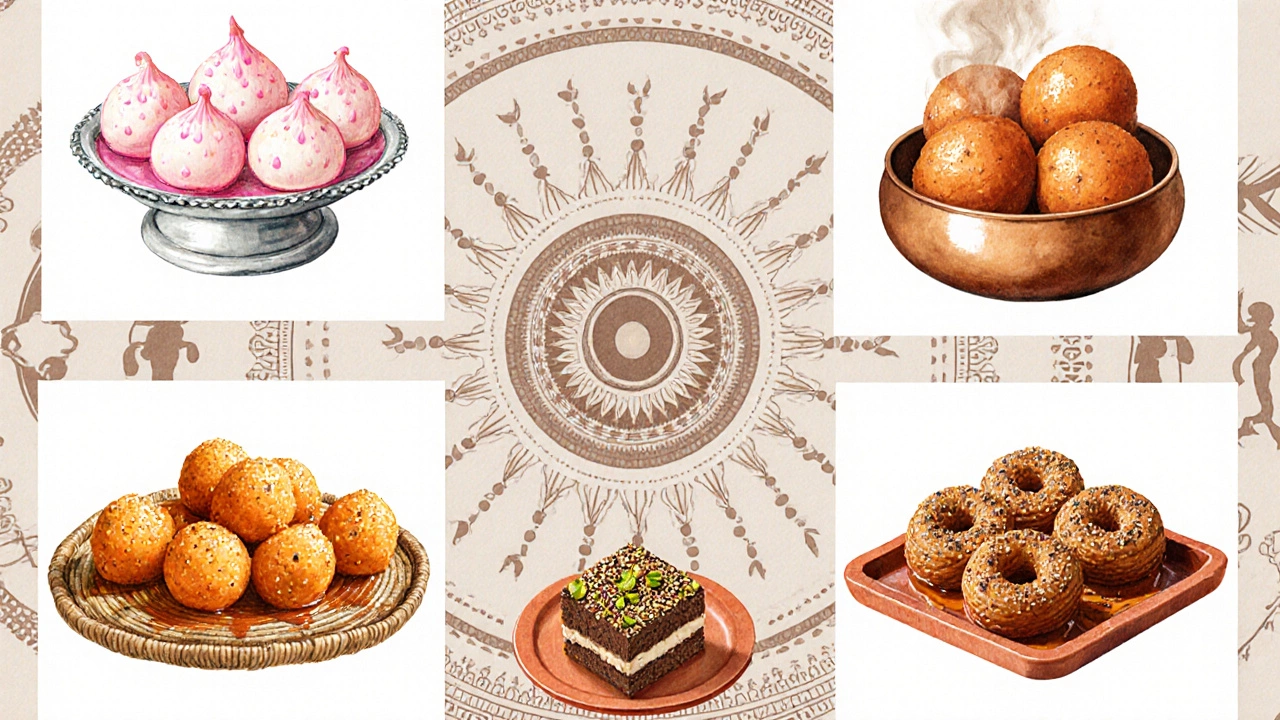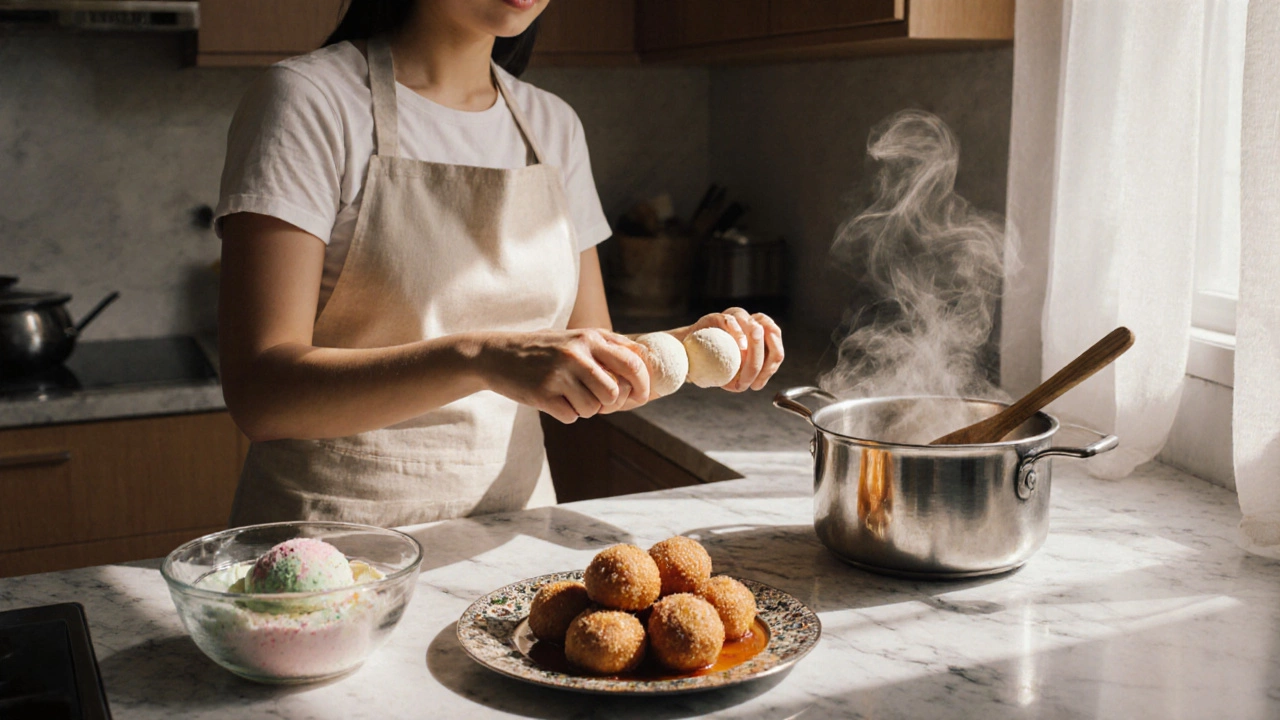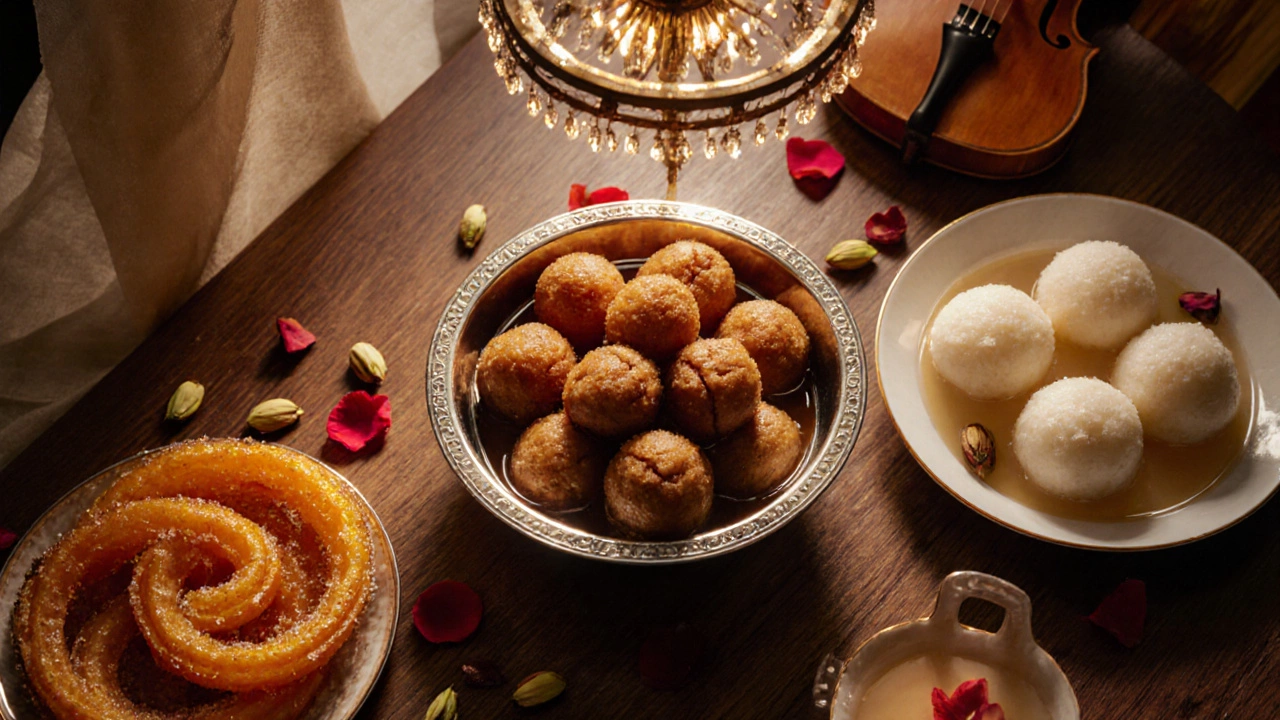Sweet Occasion Selector
Match Your Occasion with the Perfect Sweet
Select your event type to discover which traditional Indian sweet is most appropriate for your celebration.
Recommended Sweet
Region:
Indian sweets are more than just desserts - they’re a language of celebration, comfort, and regional pride. Whether you’re at a family wedding in Delhi or sharing a snack with friends in Chennai, the sweet you reach for tells a story. This guide walks you through the most loved treats, why they matter, and how you can enjoy them at home or on the go.
Key Takeaways
- Gulab Jamun, Jalebi, and Rasgulla top the national popularity charts.
- Each Indian state has a signature sweet that reflects local ingredients.
- Most traditional sweets use simple bases - milk, sugar, and a grain or flour.
- Home‑cooked versions are often healthier and customizable.
- When buying, look for freshness, proper texture, and authentic flavor notes.
Why Indian Sweets Matter
India’s culinary landscape is incredibly diverse, and sweets are no exception. They appear at every milestone - births, graduations, festivals like Diwali and Holi, and even everyday tea time. The flavors can be aromatic (cardamom, saffron), nutty (almond, pistachio), or tangy (lime zest). Understanding the cultural backdrop helps you choose the right sweet for the right moment.
Regional Favorites at a Glance
| Region | Signature Sweet | Main Ingredients | Typical Occasion |
|---|---|---|---|
| North India | Gulab Jamun | Milk solids, sugar syrup | Weddings, festivals |
| West Bengal | Rasgulla | Chhena (cottage cheese), sugar | Poila Boishakh, gifting |
| Maharashtra | Poha Ladoo | Flattened rice, jaggery | Ganesh Chaturthi |
| South India | Jalebi | All‑purpose flour, sugar syrup | d>Ramadan, brunch |
| Punjab | Besan Barfi | Gram flour, ghee, sugar | Birthday celebrations |
Sweet Spot: Profiles of the Most Loved Indian Confections
Gulab Jamun is a deep‑fried milk‑based ball soaked in aromatic sugar syrup. Soft, spongy, and often flavored with rose water or cardamom, it’s a staple at any North Indian feast.
Jalebi is a crisp, coiled pastry drenched in saffron‑tinged syrup. Its bright orange hue makes it a visual treat, and the contrast between crunchy exterior and syrupy interior is addictive.
Rasgulla is spongy cheese balls that float in a light sugar syrup. Originating from Odisha and Bengal, these bite‑size pearls are often served chilled.
Ladoo is a round ball made from roasted flour, nuts, and sweeteners. Variants include Besan Ladoo (gram flour), Motichoor Ladoo (tiny gram flour pearls), and Coconut Ladoo.
Barfi is a dense, fudge‑like sweet made from condensed milk and flavorings. Common flavors are pistachio, almond, and cocoa.
Kheer is a creamy rice pudding simmered with milk, sugar, and spices. It doubles as a dessert and a comfort food.
Halwa is a thick, buttery confection often based on semolina, carrots, or lentils. Gajar Halwa (carrot) and Suji Halwa (semolina) are festival favorites.
Peda is a soft, milky sweet shaped into flat discs, usually flavored with cardamom. It’s popular in Uttar Pradesh and Maharashtra.
Mysore Pak is a rich, grain‑flour based sweet from Karnataka, cooked with ghee and sugar until glossy. Its slight grainy texture sets it apart.

Choosing the Right Sweet for Any Occasion
Not every sweet suits every moment. Here’s a quick cheat‑sheet:
- Festivals (Diwali, Holi): Go for bright, syrup‑heavy sweets like Jalebi or Pedas. They pair well with fireworks and tea. \n
- Weddings: Opt for luxurious, melt‑in‑your‑mouth treats like Gulab Jamun, KesarBarfi, or premium Peda.
- Everyday tea break: Light options such as Ladoo, roasted Sesame Ladoo, or small Kheer portions keep calories in check.
- Health‑focused gatherings: Choose sweets made with jaggery, nuts, and less ghee - for example, Poha Ladoo or Date Halwa.
Simple Home Recipes to Try Today
Recreating these classics at home lets you control sweetness and experiment with flavors.
Quick Gulab Jamun (No‑Fry Version)
- Mix 200g of milk powder, 50g of all‑purpose flour, and 1tsp baking powder.
- Add 100ml warm milk and 1tbsp melted ghee; knead into a soft dough.
- Form small smooth balls; set aside for 10minutes.
- In a saucepan, bring 500ml sugar syrup (1part sugar, 1part water) to a gentle boil; add a pinch of cardamom.
- Steam the balls for 8‑10minutes instead of deep‑frying. Then gently drop them into the warm syrup for 5minutes.
- Serve warm or at room temperature.
Easy Jalebi Using Ready‑Made Batter
- Buy a pre‑made jalebi batter (usually made from fermented flour).
- Heat oil in a wide pan; pour batter in a spiral using a squeeze bottle.
- Fry until golden, then immediately dip in warm sugar syrup infused with a few saffron strands.
- Let excess syrup drip off; serve hot.
Tips for Buying Quality Indian Sweets
When you shop at Indian grocery stores or specialty shops, keep an eye on these factors:
- Freshness: Soft sweets like Rasgulla should feel springy, not mushy.
- Texture: Gulab Jamun must be uniform, with a slight crack on the surface, indicating proper frying.
- Aroma: Genuine cardamom, rose, or saffron fragrance signals authentic ingredients.
- Ingredient list: Look for real milk solids, ghee, and natural sweeteners; avoid excessive preservatives.
- Packaging: Airtight containers preserve moisture and prevent crystallization of syrup.

Common Misconceptions About Indian Sweets
Many people think Indian sweets are always ultra‑sweet and unhealthy. In reality, regional variations balance flavors with nuts, spices, and even savory elements. For instance, sesame‑seed Ladoo often uses jaggery, which has a lower glycemic index than refined sugar. Similarly, Kheer can be made with low‑fat milk and a modest amount of honey.
From Plate to Party: Serving Ideas
Presentation matters. Arrange small sweets on banana leaves for a rustic look, or use tiered trays for weddings. Pair Gulab Jamun with a scoop of kulfi, or serve Jalebi alongside a dollop of fresh curd to cut the sweetness. These little touches elevate the experience without extra cost.
Frequently Asked Questions
Which Indian sweet is best for a diabetic friend?
Opt for sweets sweetened with jaggery or stevia, such as Poha Ladoo or Date Halwa. Keep portion sizes small and pair with high‑fiber foods like roasted nuts.
How long can homemade Indian sweets be stored?
Syrup‑based sweets (Gulab Jamun, Jalebi) stay fresh 3‑4days refrigerated in airtight containers. Drier treats (Ladoo, Barfi) can last up to 2weeks if kept cool and dry.
Can I make Indian sweets vegan?
Yes. Replace dairy milk with coconut or almond milk, use plant‑based butter alternatives, and swap ghee for coconut oil. Vegan Gulab Jamun made with soy milk powder works well.
What spices are essential in Indian sweets?
Cardamom, saffron, and rose water are the most common. Nutmeg and clove appear in richer desserts like Kesar Barfi, while black pepper is sometimes added to savory‑sweet combos.
Why do some sweets taste better the next day?
Syrup‑soaked sweets like Gulab Jamun absorb more flavor as they sit, leading to a richer taste after a few hours. This is why many families prepare them a day ahead of celebrations.
